Shotguns don’t always seem like the type of firearm that beckons for a scope, but there are reasons why people buy and mount shotgun scopes.
Shotgun Scopes For Deer
Deer season ended with all four members of my hunting crew tagged out. Our one non-family member, Mike, was still itching for action, so he packed up his truck for a two-day drive to southern Illinois. His destination was a relative’s farm in prime deer country, timed for their opening day.
I’d been expecting an update on the action. When the call finally arrived a few days later, Mike was perched in a tree stand. The conversation had barely commenced when he declared a time out… followed by a shot. A nice eight-pointer had strutted into view at around 110 yards, whereupon it was tipped over by a 12 gauge slug.
But not any slug. The area Mike was hunting was shotgun-only. It was also farmland dotted with fields. Like other such zones, most deer hunters were after every edge possible to gain additional range.
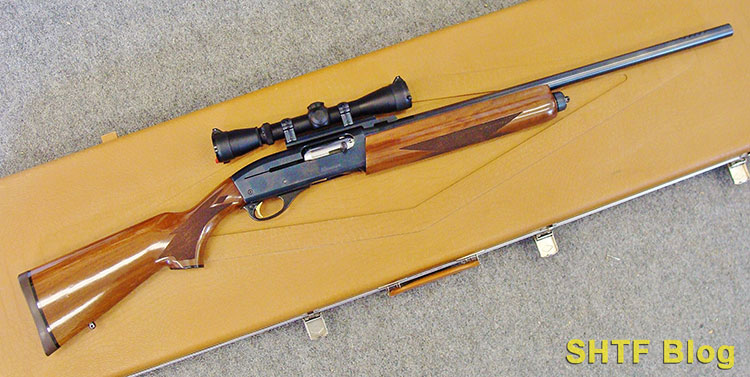
Rifled Slugs
Mike’s solution was a supply of Winchester BRI slugs, marketed for use in rifled shotgun barrels. The actual “slug” is a .50-caliber hourglass shaped lead bullet, encased within a two-piece plastic sleeve (the sabot). Upon discharge, the sabot is engaged by the rifling, which spins the entire projectile.
Once clear of the muzzle, the sabot halves separate, providing a stabilized and exceptionally accurate shotgun “slug.” How accurate? Well, Mike’s Remington Model 1187 autoloader can drill three BRIs into a two-inch circle at 100 yards!
| Shotgun Slug | Purchase Link |
|---|---|
| Winchester BRIs | Optics Planet |
| Hornady SST 300 | Optics Planet |
| Winchester XRS-12 | Optics Planet |
Beyond the load, his special sauce is an aftermarket rifled Hastings barrel, built with a cantilever scope base. The forward end of the base is welded to the barrel, and the rest of it extends rearward above the receiver.
It’s machined to accept common scope rings of the popular Weaver pattern. The beauty of this design is, once a scope is mounted, it’ll remain zeroed throughout barrel exchanges. Accuracy of this level warrants a decent scope. Mike’s is a Leupold 2-7X Shotgun Scope, a great all-around choice for deer.
BRI sabots actually appeared around fifty years ago, mainly for use by law enforcement. Recognizing its tremendous hunting potential, Winchester picked up the BRI line and expanded it. Since then, a number of other flatter-shooting saboted-slugs have evolved, in both 12 gauge and g0 Gauge offerings.
Hornady’s 12 Ga. SST launches a 300-grain pointed bullet at around 2000 fps, fast enough to cover 200 yards! But, velocity isn’t everything. As a champion skeet shooter, Mike sticks with 1350 fps BRIs to approximate the leads of his target shells.
The sabot-slug developments caught the attention of shotgun manufacturers, who launched “deer” versions of their existing models with rifled barrels. Good move! As it turns out, even a “smaller” 20 Gauge can rival the performance of modern .45/70 loads through fast-handling pumps or autoloaders.
Rifled Barrels
A rifled accessory barrel is another possibility. Using Mike’s M-1187 as an example, the swap from his vent-rib bird barrel is a breeze, as it is for most other autoloaders or pumps. Add a rifled barrel and you gain a useful two-gun system consisting of your bird gun, and a “rifle.” One wrinkle may be its stock, probably too low for a decent gun mount due to the extra height of a scope.
Some gun makers address this issue through stocks with higher combs, but most will then be too high for the bird barrel. Some of the latest modular stocks solve this problem through comb-inserts; a great solution. Another fix is a temporary cheek-pad, secured to the stock by straps or laces.
Rifled shotgun barrels will shoot traditional lead Foster-type slugs, but the result will be a thick plating of residual lead. But, better results are possible with a rifled choke tube. It’ll be much easier to clean and, despite its short length, you may see a meaningful accuracy improvement. Sabot loads may even work. The key to discovery is a viable aiming system.
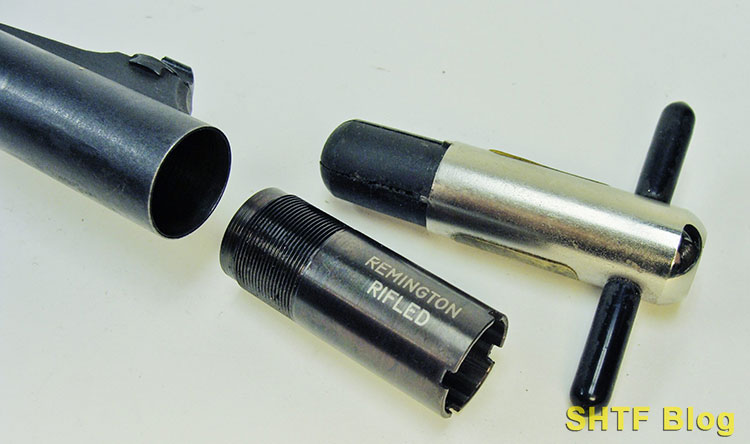
But, forget shot loads. A rifled barrel will produce widely “blown” patterns – on the order of 40-yard spreads at 7 yards. Which doesn’t rule out the use of a scope with shotshells.
Shotgun Scopes For Turkeys?
My friend, Bud, is a true turkey maestro. He was hunting them in other states before any were reintroduced to ours (a project Bud was heavily involved in). Traditional turkey armament has long consisted of a 12 gauge shotgun and stiff 3-inch loads of #4 -6 shot, concentrated on a turkey’s neck and head through the use of tight choke-tubes.
Bud has seen his share escape unscathed due to tight patterns and excited hunters. Unless a solid cheek-weld is maintained, the swarm of shot will probably overshoot the bird – a common occurrence with adrenaline flowing. One solution is a scope. Bud sprang for the same Leupold 2-7X Shotgun scope as Mike’s, but it needed a different mounting system.
A gunsmith drilled and tapped his trusty M-1100’s receiver, bases were attached, and the scope was solidly mounted – or so Bud thought. Stiff magnum loads generate lots of G-forces. Within short order the scope departed, leaving stripped receiver threads. An 1100 begins as a solid block of steel. Nowadays, most other receivers are aluminum.
Alternative Shotgun Optics
Bud’s gunsmith was able to rescue the receiver through use of larger screws and installation of a one-piece Weaver base. Rather than risk further destruction, the G-load was reduced by a switch to a miniaturized red-dot sight.
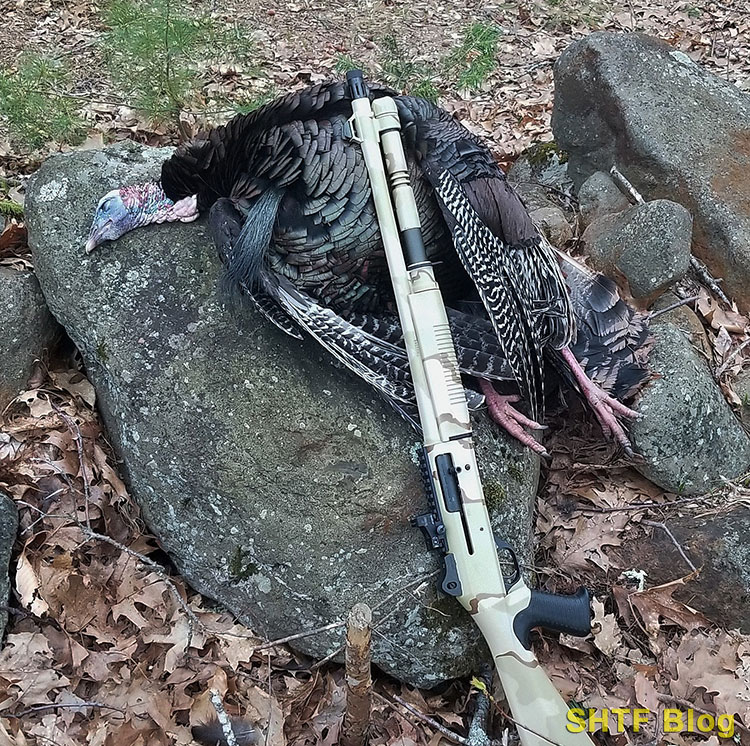
MRDS Systems
Compact electronic dot-sights are here to stay. The larger tube designs (enclosed emitters) were a good match for AR-15s, but the tubeless miniaturized versions (open-emitters) have even spawned a new wave of MRDS-compatible handguns. Of interest to some shotgunners, three-gun competitors embraced these sights and began chalking up higher scores on all stages, especially those involving slugs.
One earlier example is the Burris Fast-Fire mounted to the Picatinny rail of my son’s 12 gauge Benelli M-4 semiauto. It’s held up surprisingly well for nearly a decade despite a steady diet of heavy shells employed for everything from turkeys through deer. Although contrary to conventional wingshooting doctrine, he even uses this sight to good effect on airborne crows.
My interest was reactive steel engaged at rapid rates. As an experiment, I mounted a Burris FF-III to my Beretta Model 1301 Competition 12 Ga. autoloader. Its aluminum receiver was factory-drilled, so I ordered a Picatinny base from Beretta, dabbed the screws with blue thread-sealer, and mounted the sight.
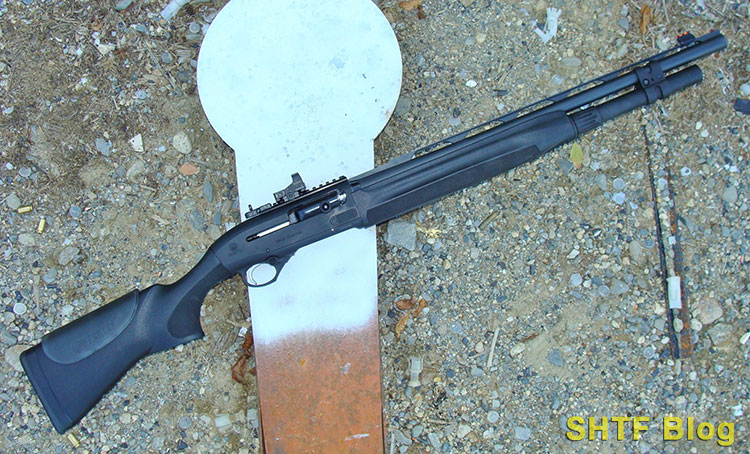
It soon became apparent this system had further potential, both for turkey hunting and ala carte deer hunts. But, the increase in sight height called for an add-on cheek riser – a less than suitable wingshooting arrangement. One surprise; after several successful turkey seasons involving 3” Magnums, one day I noticed the base had loosened.
The fix would’ve been easy, but I’ve since returned to the original bare-receiver and its 24-inch, dual-bead, vent-rib barrel. No regrets, no battery worries, still lots of dead turkeys, and a much more intuitive wingshooting system.

But, that’s just me. For some, an MRDS could be a viable alternative to a scope. Burris sells a Fast-Fire built specifically for some popular shotgun models; their SpeedBead Shotgun Sight. It mounts to a vertical plate sandwiched between the stock and receiver junction, resulting in a rock-solid mount. Aimpoint’s Micro S-1 is a pricier enclosed-emitter version that can mount to a ventilated rib.
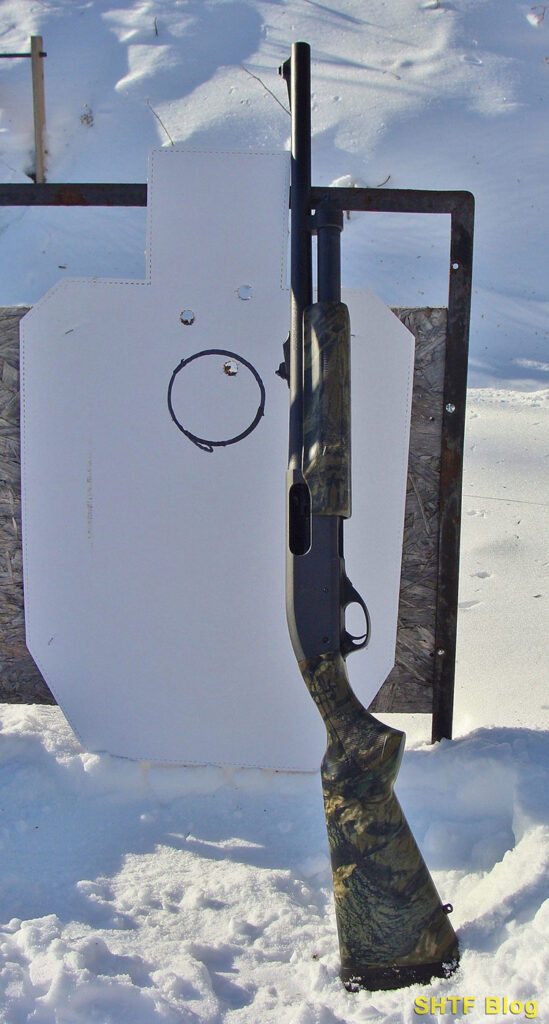
Ghost Ring Sights
My background involves sporting and law enforcement shotguns, each of which pose unique concerns. For sporting use (with the exception of slugs), I’d rather use a plain bead (see below).
A ghost-ring is a “peep” (or receiver sight) with a large aperture. Several of my lever-action rifles are so equipped for fast woods action in bad weather. Being “fast”, the same rugged system has value for a defensive shotgun. A shooter’s eye will naturally center a front sight in the aperture, resulting in surprisingly accurate shots.
We sent a few 21-inch Remington Model 870 pump-guns to Wilson Combat/Scattergun Technologies. When they reappeared, they were 14-inch NFA versions with ghost-ring sights – darned handy in tight places. And fast!
Open Sights
I maintained an armory full of Remington Model 870 Police pump-guns with 21-inch barrels and adjustable open sights. We had an extremely active shotgun program that encompassed everything from reactive steel to slug stages – fired against the clock, using shot-timers.
We found, when striving for maximum speed on steel plates with shot loads, sights would add about 0.2 second over a plain bead-barrel from a ready position – a small price to pay given the extra hits. The sights really shined at 50 yards.
If fired supported, three Winchester 1 oz. Super-X 2 ¾” plain Foster-type slugs could be placed within a three-inch circle. Sometimes, simple can be good. No batteries. No wet, or snow-packed lenses.
A Plain ‘Ol Bead
Airborne clay pigeons are hit as follows: Head on stock – hard focus on target – press trigger.Sounds counterintuitive, but if you aim, you’ll probably miss – especially if the target is a crosser.
Sights encourage aiming but the correct technique requires pointing, something most of have done as toddlers. Like your fingertip, the muzzle is more of a blur. Alternate wingshooting systems sometimes appear, but the top-tier claybird competitors stick with beads to avoid the dreaded “aiming” trap.
Of course, their shotguns shoot where they’re pointing. Not all shotguns do, which calls for a few trial patterns. The downside to a bird barrel involves slugs. Some folks limp by, but accuracy will be iffy, so ranges should be short.
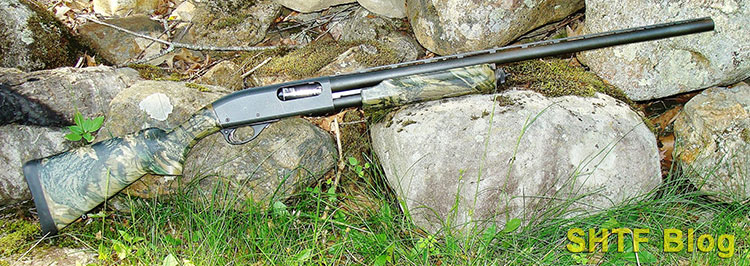
Is a Scoped Shotgun Worth the Bother?
Well, possibly…
Turkey Hunters
Today’s loads produce ultra-dense patterns. Particularly at close or mid-range distances, precise shooting is much more critical, increasing the value of a scope (or smaller dot sight).
Deer Hunters
In shotgun-only jurisdictions, a scope makes perfect sense on a rifled barrel, given today’s flat-shooting sabot slugs.
Homesteaders or Preppers
Or, anyone seeking one affordable general-purpose firearm could do worse than a basic pump shotgun, capable of accepting extra barrels.
Using Remington’s Model 870 Express as an example, a standard 26-28-inch ventilated-rib version with interchangeable choke tubes will handle just about everything from feathers to fur. A spare, inexpensive smoothbore, slug barrel with rifle sights is a better for big game out to around 75 yards, and it will also serve well for defensive.
But, if you add a rifled barrel, for all intents and purposes, you gain a high-powered rifle capable of taking anything in North America out to 150 yards – or further, assuming you have the right scope.
Shotgun Scope Features
Most so-called “shotgun scopes” offer generous eye relief of around four inches or more. Some are also parallax-corrected for closer distances (although sabot loads make this less of an issue). Heavy-duplex reticles, if offered, are great for heavy timber or low light. But, the latest trajectory-compensating designs can stretch a fast sabot-load to equal (or surpass) some classic deer calibers, reaching 200-yards.
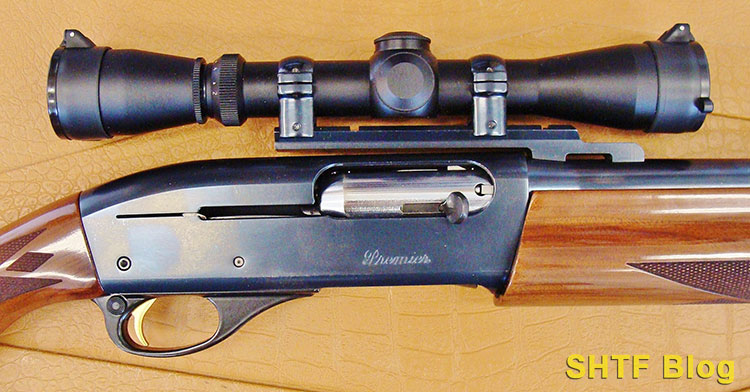
A few purported “best” shotgun scopes check the above boxes, but are heavy. Even in better mounts, the inertial effects of recoil may induce subtle ring creep – just enough to cause a zero shift. For this reason I like lighter scopes. Two that qualify as useful shotgun picks are sold by Leupold. Both retail for $300:
- Leupold’s Freedom 1.5-4×20 can be purchased with a Pig-Plex reticle, and it weighs a feathery 9.6 ounces.
- Leupold’s VX Freedom 3-9×40 Muzzleloader Ultimate Slam incorporates a hold-over reticle that also works with slugs. Weight is only 12.2 oz.
Mounts
The above scopes have one-inch tubes which are long enough to establish optimum eye relief. Regarding mounts, strong steel rings are less likely to shear than cheaper pot-metal types. Some folks draft their bird guns for slug duty by installing stamped steel “saddle-mounts” that are secured via crossbolts through the receiver’s trigger-pin holes. They complicate maintenance limit the gun’s versatility. A receiver-mounted system solves the maintenance issue, but wingshooting is still out.
Final Thoughts
Go with a cantilever barrel and you can realize your shotgun’s true potential. Two hugely popular pump-gun choices are the Remington M-870, and Mossberg Model 500. The M-870 went out of production during the recent interruption (when Remington went broke), but millions of used guns are out there and, thanks to new management, the 870 is back.
Meanwhile, Mossberg remains its chief competitor for many good reasons. Their two-barrel, dual-comb, Field/Deer Combo is a ready-made package. Semiauto deer guns are another possibility. Most also produce less felt recoil, especially when purchased as 20 gauges.
| Noted Shotgun Optics | Purchase Link |
|---|---|
| Leupold 2-7X | Optics Planet |
| Burris FastFire Reflex | Amazon |
| Leupold Freedom 1.5-4×20 | Optics Planet |
| Aimpoint Micro S-1 | Optics Planet |
An accessory barrel is a possibility for some shotgun owners. Perfectly serviceable, used, cantilevered specimens are out there, and installing one is a cinch. Simply unscrew the gun’s retaining cap, pull off the barrel, and make the swap.
When not in use, your rifled barrel can remain on standby, pre-zeroed, and ready for action. Meanwhile, for what it’s worth, you’ll be the owner of a PC firearm (if there truly is one), legal just about everywhere.
Make sure you have the right scope mounts, and for novice shooters, make sure there is enough space so they don’t end up with a black eye from the recoil. If recoil is an issue (causes flinching), see my article on ways to reduce shotgun recoil.
A rifled barrel will maximize the versatility of a shotgun – but it still isn’t the best route for everyone. Recently, a few shotgun-only states have legalized the use of straight-walled metallic cartridges during their deer seasons. Although all are not legal, Winchester’s new .350 Legend qualifies, having been developed expressly for this purpose. AR enthusiasts will appreciate the option to simply attach a .350 Legend upper and expand the versatility of their AR platform.
In such areas, I’d still want a shotgun, but a new rifle or AR-15 upper receiver would be my choice for deer. The .350 Legend will easily cover 200 yards with less recoil, and lower per-round cost.
Steve Markwith is the author of several books on firearms and shooting, including Shotguns: A Comprehensive Guide.
- Markwith, Steve (Author)
- English (Publication Language)
- 190 Pages - 11/27/2014 (Publication Date) - PrepperPress.com (Publisher)


